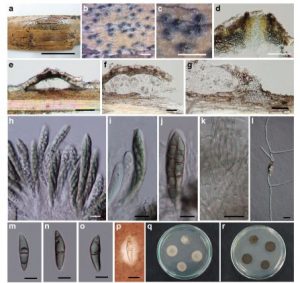Occultibambusa bambusae D.Q. Dai & K.D. Hyde, sp. nov. Index Fungorum number: IF552016
Etymology: Refers to the bamboo host.
Holotype: MFLU 15–1212
Saprobic on dead bamboo culms, forming dark, round spots on host surface, with ascostromata on raised areas, butstill immersed under host tissue. Sexual morph: Ascostromata 150–200 μm high, 400–550 μm diam., solitary, scattered, immersed, subglobose, slightly conical in section, uni-loculate, black at the ostiolar regions, coriaceous, with a central, rounded, papillate ostiole, lined internally with periphyses. Peridium comprising host and fungal tissues, 30–45 μm thick, composed of brown to hyaline, thick- to thin-walled cells of textura angularis, intermingled with host cells, with basal part 15–30 μm thick; wedge of palisade-like cells at the periphery: 50–100 μm thick, composed of large, brown cells. Hamathecium composed of long, 2–3.5 μm wide, septate, cellular pseudoparaphyses branching above the asci. Asci (50–)60–80(−90) × (9.5–)11.5–14.5(−15) μm (x = 70.8 × 13.1 μm, n = 20), 8-spored, bitunicate, broadly cylindrical, with a short furcate pedicel, with a shallow ocular apical chamber. Ascospores (22–)23.5–27.5 × 4.5–7 μm (x = 25.7 × 6.3 μm, n = 20), 2–3-seriate, slightly broad and fusiform, 1-septate, occasionally with larger upper cell, narrowly acute at both ends, dark brown, straight to curved, surroundedby a gelatinous sheath, each cell with 2–3 guttules. Asexual morph: Undetermined.
Cultural characters: Ascospores germinating on PDA within 24 h with germ tubes produced from both cells. Colonies growing slowly on PDA, reaching 1.5–2 mm in 18 days at 28 °C, under 12 h light/12 h dark, circular, floccose, with even margin, dark brown above and below. Mycelium immersed and superficial in the media, composed of branched, septate, smooth-walled, brown hyphae. Occultibambusa bambusae can produce ascomata on bamboo pieces on WA after 3 months, however, asexual morph are not observed from culture.
Material examined: THAILAND, Chiang Rai Province, Mae Fah Luang Unversity, on dead culms of bamboo, 9 July 2013, Dong-Qin Dai, DDQ00262 (MFLU 15–1212, holotype); Ibid. (KUN HKAS88749, isotype), ex-type living cultures, MFLUCC 13–0855, CBS 139960, MUCL 55882;Chiang Mai, Mae Sae Village, on dead culms of bamboo, 14 May 2011, Dong-Qin Dai, DDQ00025 (MFLU 16–0880), living culture, MFLUCC 11–0394.
Notes: Occultibambusa bambusae is similar to O. fusispora in having clavate asci and fusiform, dark brown ascospores. However, O. bambusae differs in its larger ascomata (150–200 μm high, 400–550 μm diam. vs. 135– 185 μm high, 240–275 μm diam.). The branch length of phylogenetic tree shows they are different species (Fig. 13)
FIG. Occultibambusa bambusae (MFLU 15–1212, holotype). a–c Ascostromata developing on bamboo culm. d Ostiole with periphyses. e,f Vertical section of ascostroma (e Ascostroma with wedge of palisade like cells at the periphery). g Wall of ascostroma. h–j Asci containing ascospores. k Pseudoparaphyses. l Germinating ascospore. m–o Dark brown ascospores with a single septum. p Ascospore with gelatinous sheath. q, r Cultures on MEA. Scale bars: a = 5 cm, b, c = 500 μm, e = 100 μm, d, f, g = 50 μm, h–p = 10 μm

